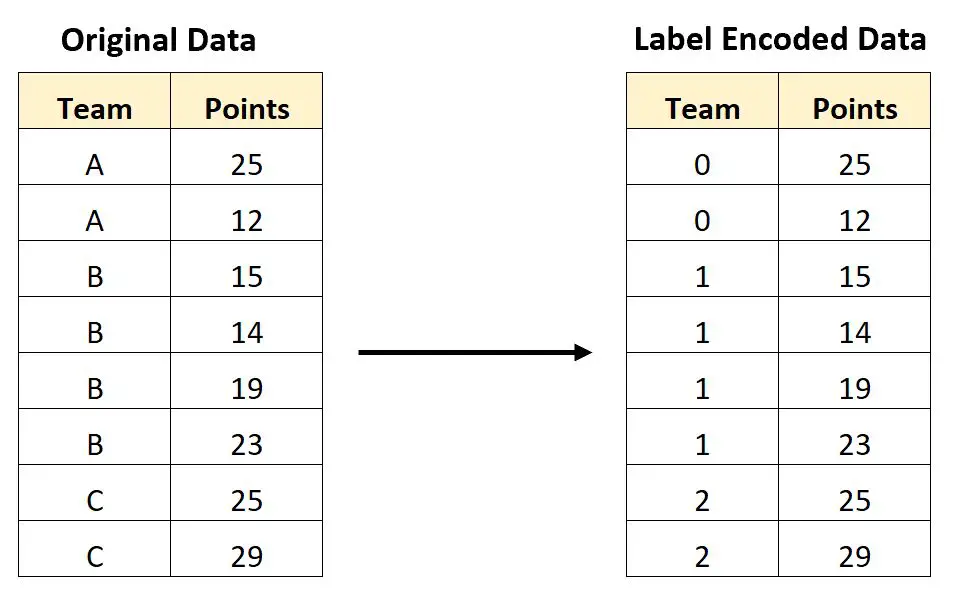Scikit-learn:使用多列标签编码
在机器学习中,标签编码是将分类变量的值转换为整数值的过程。
例如,以下屏幕截图显示了如何将名为Team的分类变量的每个唯一值转换为基于字母顺序的整数值:

您可以使用以下语法在Python中执行多列标签编码:
from sklearn. preprocessing import LabelEncoder #perform label encoding on col1, col2 columns df[[' col1 ', ' col2 ']] = df[[' col1 ', ' col2 ']]. apply (LabelEncoder(). fit_transform )
以下示例展示了如何在实践中使用此语法。
示例:在 Python 中编码标签
假设我们有以下 pandas DataFrame,其中包含有关各种篮球运动员的信息:
import pandas as pd
#createDataFrame
df = pd. DataFrame ({' team ': ['A', 'A', 'B', 'B', 'B', 'C', 'C', 'D'],
' position ': ['G', 'F', 'G', 'F', 'F', 'G', 'G', 'F'],
' all_star ': ['Y', 'N', 'Y', 'Y', 'Y', 'N', 'Y', 'N'],
' points ': [11, 8, 10, 6, 6, 5, 9, 12]})
#view DataFrame
print (df)
team position all_star points
0 AGY 11
1 AFN 8
2 BGY 10
3 BFY 6
4 BFY 6
5 CGN 5
6 CGY 9
7 DFN 12
我们可以使用以下代码执行标签编码,将team 、 position和all_star列中的每个分类值转换为整数值:
from sklearn. preprocessing import LabelEncoder #perform label encoding across team, position, and all_star columns df[[' team ', ' position ', ' all_star ']] = df[[' team ', ' position ', ' all_star ']]. apply (LabelEncoder(). fit_transform ) #view udpated DataFrame print (df) team position all_star points 0 0 1 1 11 1 0 0 0 8 2 1 1 1 10 3 1 0 1 6 4 1 0 1 6 5 2 1 0 5 6 2 1 1 9 7 3 0 0 12
从结果中我们可以看到team 、 position和all_star列的每个值都已转换为整数值。
例如,在团队一栏中我们可以看到:
- 每个“A”值已转换为0 。
- 每个“B”值已转换为1 。
- 每个“C”值都转换为2 。
- 每个“D”值都转换为3 。
请注意,在本示例中,我们对 DataFrame 的三列执行了标签编码,但我们可以使用类似的语法对任意数量的分类列执行标签编码。
其他资源
以下教程解释了如何在 Python 中执行其他常见任务:
如何在 Pandas 中将分类变量转换为数值
如何在 Pandas 中将布尔值转换为整数值
如何使用 Factorize() 将字符串编码为 Pandas 中的数字